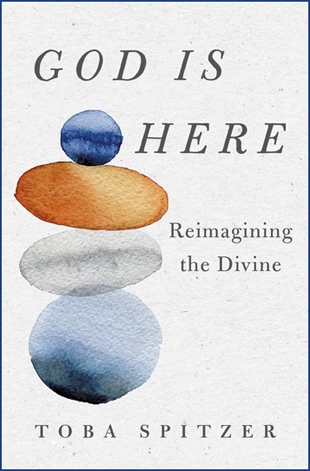The author of this book has been one of the most respected liberal rabbis in the United States for a quarter century. She has served Congregation Dorshei Tzedek in West Newton, Massachusetts (suburban Boston) since 1997 and is past president of her denomination’s rabbinical organization. In 2008, Newsweek magazine named her one of the top fifty rabbis in the United States.
This is her first book, one that seems to summarize a career of helping people reimagine God and discover the sacred in their lives. Spitzer writes for a broad audience. She explains at the outset:
“Let’s say you walk into a restaurant that you’ve heard a lot about. You’re looking for something to satisfy your hunger and give you strength to get through the day. The waiter hands you the menu, and you sit back, scanning all the sections — salads, soups, lunch, dinner. You begin to realize, sadly, that nothing on the menu looks particularly appetizing. The choices sound bland, unsatisfying, or just strange. Much of the menu is incomprehensible. Resigned, or maybe even a little bit angry, you put the menu down and leave. You convince yourself that you’re not so hungry after all and head into your day.”
She then adds: “This is what happens to many of us as we realize we have a spiritual hunger…. We walk into the 'restaurant' of organized religion and realize there’s just too much we can’t swallow.”
Spitzer sets out to offer something more palatable. “This book is my attempt to create a new menu.” Her fresh options are not religious per se or a menu of religions but new ways of approaching what we mean when we call life divine or sacred.
We need metaphors for the sacred to replace outdated ones that are still perpetuated. Spitzer quickly discounts the God who is “out there,” the “Superpower entity,” and “the Big Person in the sky.” Some of her new metaphors become names of chapters, such as “The God-Cloud” (ch. 7) — inspired by images in the Torah relating to the ancient Israelites but then with some Joni Mitchell and teachings on gazing at the sky as well. (See the excerpt on gratitude accompanying this review.) Another fresh metaphor that is also the name of a chapter is “Holy Fire” (ch. 8), again with reference to the Hebrew Bible but also to Black Lives Matter, Hindu and Indigenous rituals, and fruitful teachings on “Tending the Fire of the Heart.”
We think you will find this a challenging and stimulating resource, if you believe that your life makes sense only when understood as sacred. As Spitzer says in her conclusion, “No one metaphor will do. As an ancient midrash teaches, just because we call God different things in different situations doesn’t mean there is more than one God. All spiritual traditions recognize this truth, and offer a plethora of metaphors to help us access the divine.”
